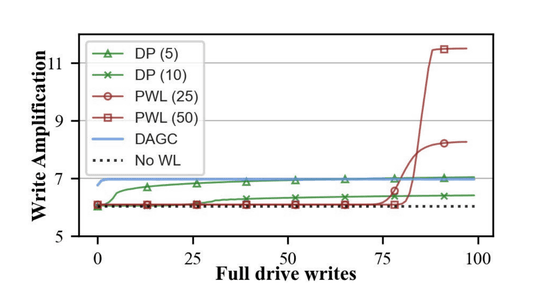Research results show that 'wear leveling,' a technology for extending the durable life of SSDs, is not effective.

SSDs, which have rapidly become widespread as storage in recent years, reach the end of their life at the upper limit of the number of writes, unlike HDDs that can theoretically be used permanently unless parts fail. '
Wear Leveling in SSDs Considered Harmful
(PDF file) https://dl.acm.org/doi/pdf/10.1145/3538643.3539750
Wear leveling in SSDs considered harmful | Proceedings of the 14th ACM Workshop on Hot Topics in Storage and File Systems
https://dl.acm.org/doi/10.1145/3538643.3539750
The NAND flash memory that composes the SSD manages the erase operation in units of data amount called 'blocks', and manages reading and writing in units of data amount called 'pages'. Wear leveling is a technology that prolongs the product life of the SSD itself while preventing data loss and failure when a specific block deteriorates by distributing and writing data to all blocks. ..
Wear leveling is mainly classified into three types: 'dynamic expression' that works only in the area where data is not written, 'static expression' that works for flash chips, and 'global expression' that works for the entire device. This time, the research team used the flash file system simulator FTLSim to use the dynamic 'Dynamic Adjust-ment Garbage Collection (DAGC)' and the static algorithms 'Dual-Pool (DP)' and 'Progressive'. We performed a maximum of 100 full drive writes using three algorithms called 'Wear Leveling (PWL)' and measured the write efficiency (WAF).
WAF is the ratio of the actual amount of data written to the NAND flash memory to the amount of data written to the SSD from the host computer. If it is an ideal storage system, the WAF will be 1.0, but the write efficiency of SSDs that are actually used is about 2-4.
SanDisk, a semiconductor company, has announced LDE (Longterm Data Endurance) , a measurement standard for estimating the life of SSDs. According to it, 'guaranteed number of rewrites' x 'capacity of the entire flash memory' ÷ 'WAF' = 'total amount of writable data' can be shown. In other words, the higher the WAF, the less total data can be written to the SSD, and the shorter the life of the SSD.
The research team performed a full drive sequential write once before the experiment on the target virtual SSD, and further performed a total of 256 GiB sequential write and a total of 768 GiB random write in three times to improve the write efficiency. rice field.
The SSD configuration built with FTLSim is as follows.
・ Page size: 4KiB ( kibibyte )
・ Block size: 1MiB ( mebibyte )
・ Number of pages per block: 256 pages
-Block processing: FIFO
・ Physical capacity: 284 GiB ( gibibyte )
-Logical capacity: 256GiB
・Over-provisioning area: 11%
The graph below summarizes the measured WAF (vertical axis) and the number of full drives (horizontal axis). Green is DP, red is PWL, blue is DAGC, and the dotted line is when wear leveling is not performed. SSDs that were not wear-leveled did not change much, while DP and DAGC increased the WAF slightly, and PWL increased rapidly after 75 times, recording a maximum of 11.94.

In addition, the research team is also conducting experiments with variable capacity, admitting that 'from the viewpoint of system design, it is easier to fix SSD with fixed capacity'. A SSD with a fixed capacity is considered to be a failure when the physical capacity falls below the logical capacity, but if the capacity is variable, the logical capacity will gradually decrease, so it can be said that the endurance life of the SSD will be extended. According to the research team, in the case of variable capacity SSD, the write efficiency reached a maximum of 6.9 with wear leveling, while the write efficiency was 2.89 without wear leveling.
Wear leveling has been a subject of considerable research, but it's actually very difficult to operate correctly, and the result is 'surprisingly ineffective and inefficient,' the research team said. In addition, the research team expects that wear leveling has reduced the durability limits of flash memory, which will be reported as an example in the near future.
Related Posts:
in Hardware, Posted by log1i_yk







